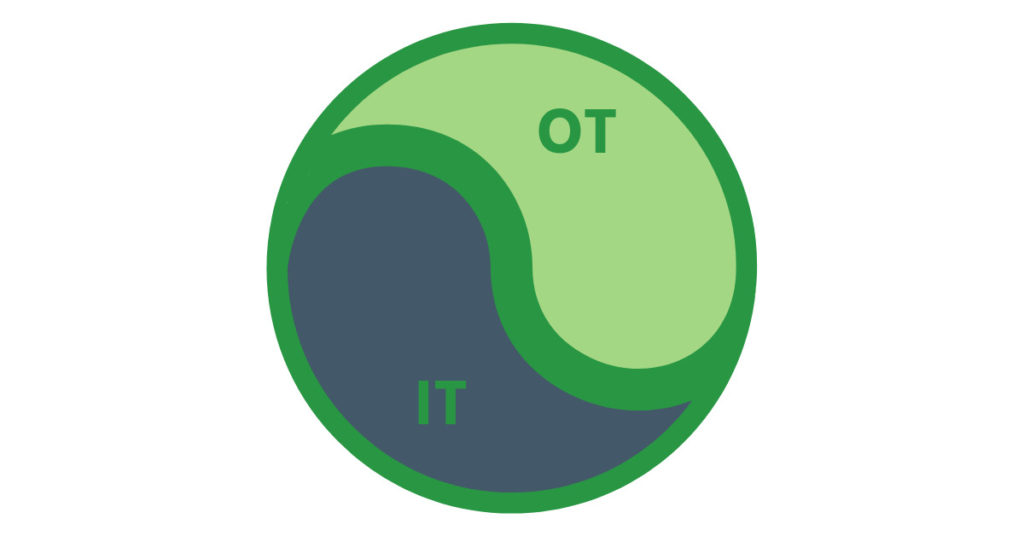One of the most important changes occurring in manufacturing at the moment is the convergence of IT and OT. This needs to be not only on your radar, but part of your current plans for improving your business today and helping you stay competitive in the future.
In most manufacturing businesses, there are two types of technology infrastructure. The first is technology that comes under the heading IT – Information Technology. The second type of technology in modern manufacturing businesses is OT – Operational Technology.
New solutions, new approaches to the use of technology in manufacturing environments, and innovative ways of thinking now make it possible for IT and OT to converge.
The benefits of IT and OT convergence are varied, but they combine to give you a competitive edge by making your business more productive, efficient, flexible, agile, and profitable.
IT Defined
IT supports the business functions of manufacturing businesses. Those functions include:
- Sales and customer relationship management
- Customer service, including end-user customer service
- Accounting
- Purchasing
- Human resources
In terms of the technology involved, IT covers all computer, server, networking, and storage devices that create, secure, process, and transmit data to support the above business units and functions.
OT Defined
OT covers technology used in the production process to control and monitor machines and equipment. Examples include:
- SCADA systems
- PLCs
- Sensors
- Meters
- Remote terminal units
The Traditional State of IT and OT
Networking and internet connectivity are often not a part of OT. Sometimes this is because vendors of machines or equipment don’t include networking functionality, or else it’s included but not utilised.
In other situations, production line machines and equipment are deliberately air-gapped for security reasons, although this is an outdated and often ineffective approach to security.
Whatever the reason for the lack of integration between IT and OT, it typically leads to machines in production environments using closed protocols that are often proprietary to vendors.
All this combined means IT and OT often exist in their own silos, with little or no interconnectivity.
However, integration across platforms, systems, and machines is now possible with modern technology.
This is the convergence of IT and OT.
Technologies Making IT/OT Convergence Possible
- Sensors
- Controls, automation, and validation software programmes
- Robotics technologies, including cobots
- Cloud technologies
- SSL encryption and other security technologies
- Improved broadband and mobile internet speeds
- Wireless technologies that are capable of operating in a production environment
- Data analytics and the use of data dashboards
- Digital twin technologies
- Big data technologies
- Machine learning and AI
The above technologies all come under the umbrella of Industry 4.0.
Benefits of IT and OT Convergence
- Efficiency savings – both in manufacturing and in wider business operations
- Productivity – through predictive maintenance capabilities, faster batch changeovers, real-time decision making, automated decision making, and improved OEE
- Better business oversight – as engineers and senior management get access to more information and higher quality data
- Improved product quality – through technologies like digital twins in addition to the improved linkage between customers using products in the real-world and the processes of product development, manufacturing, and quality control
- Enhanced customer service – customer service staff can provide faster resolutions to problems in addition to the fact that manufacturing lines experience fewer production delays. The convergence of IT and OT also enables the mass customisation and/or personalisation of products, while linking production and business processes makes it possible to better manage market demand.
Challenges of IT and OT Convergence
Of course, converging IT and OT in your manufacturing facility is not a simple process, and it’s unlikely to be a revolutionary event. There will also be challenges including:
- Compatibility issues with new and legacy systems
- Integrating systems from different vendors with different platforms
- Security issues
- Buy-in across the organisation
- The upfront investment required
With the right expertise, it is possible to overcome the above challenges to build the systems and infrastructure that will evolve your entire operation, converging IT and OT.
Opportunities Presented by IT and OT Convergence
Some of the opportunities of converging IT and OT have been highlighted above, with most of them coming under the heading of digital transformation.
This means going beyond digitising selected processes in your business to digitalising the entire business.
This is what will give you a competitive edge.





